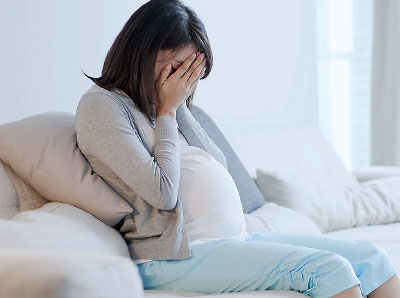Mood Symptoms in Pregnant Women May Not Be Fully Resolved by SSRIs
Abstract
A study tracking pregnant women’s mood symptoms month to month found that generally symptoms were well controlled, but about one-third of women experienced subthreshold levels of depression and/or anxiety, particularly in the final weeks of pregnancy.

Many studies have explored the risks of antidepressants during pregnancy, but few have tracked how well antidepressants manage a mother’s mood symptoms over the course of pregnancy.
“If we are going to ask our patients to use a medication during pregnancy, we have to be confident that the disease is riskier than the medicine,” said Katherine Wisner, M.D., the Norman and Helen Asher Professor of Psychiatry and Behavioral Sciences and a professor of obstetrics and gynecology at Northwestern University Feinberg School of Medicine. Wisner recently co-wrote a paper in Psychiatric Research & Clinical Practice that describes how she and her team prospectively monitored the trajectory of depression and anxiety symptoms in women taking antidepressants during pregnancy and the postpartum period.
“Currently in depression care, we often make our calculations on the assumption that women’s symptoms will be well controlled throughout pregnancy,” she said. As Wisner’s study uncovered, that is not the case for many women.
The study involved 88 pregnant women from one of three academic medical centers (Northwestern University, University of Texas-Galveston, and University of Pittsburgh) or a rural health center (Marshfield Clinic Health System in Wisconsin). All the participants were 18 weeks pregnant or less with a singleton pregnancy; had at least one prior episode of major depressive disorder; and were taking sertraline, fluoxetine, citalopram, or escitalopram with the intent of maintaining treatment throughout pregnancy.
Wisner noted that the women’s decision to continue treatment was made along with their clinicians before being approached for this study, and their clinicians continued to monitor the women’s medications during the study.
The women were assessed for depression and anxiety every four weeks until delivery and again at six and 14 weeks postpartum using such scales as the Edinburgh Postnatal Depression Scale (EPDS) and the Generalized Anxiety Disorder Scale, 7-item (GAD-7). Women who scored 15 or more on the EPDS screen and 10 or more on the GAD-7 were considered to have probable depression or anxiety.
The longitudinal assessments revealed three trajectories of depressive symptoms among the women: 18% of women experienced consistently low EPDS scores (below 5) during pregnancy, 50% experienced mild symptoms (EPDS scores around 8) early in pregnancy that dropped slightly at the end of the first trimester, and 32% had subthreshold symptoms (EPDS scores around 11) in early pregnancy that dropped after delivery but then rose again during the postpartum period.
The analysis also identified four trajectories for anxiety symptoms, three of which were similar to the patterns seen for depression: 7% of women had no anxiety (GAD-7 scores of 0) consistently through pregnancy, 53% had minimal anxiety (GAD-7 scores around 2) throughout pregnancy, and 23% had mild symptoms (GAD-7 scores around 8) at the start of pregnancy that gradually dropped around the time of delivery before rising slightly during the postpartum period. However, 18% of the women experienced breakthrough anxiety, in which their GAD-7 scores were low at the start of pregnancy but then rose almost to 10 starting at the end of pregnancy and to about eight weeks postpartum.
“Nearly 1 in 3 women had clinically meaningful depression symptoms, while 40% had difficulties with anxiety,” Wisner said. “Many of these women were not doing well, and this is from a group who had a history of responding to medication. These results show how risky depression can be during pregnancy.”
Wisner suggested that clinicians should monitor patients regularly for any emerging depression or anxiety and encourage patients to use online tools to help monitor their symptoms.
“These findings show that there is still a problem of undertreating depression during pregnancy,” said Jennifer Payne, M.D., a professor of psychiatry and neurobehavioral sciences and director of the Reproductive Psychiatry Research Program at the University of Virginia. She explained that while physicians typically augment treatment if a pregnant woman has problems controlling diabetes or hypertension, they tend to be more hesitant when it comes to increasing a pregnant woman’s antidepressant dose.
“They try to limit exposure [of the fetus to the antidepressant] rather than treat the illness,” said Payne, who was not involved in this study. She and colleagues recently did an analysis that found women with depression are far more likely to receive a medication dose adjustment during the postpartum period compared with during pregnancy. In this study, just 18 of the 88 participants were given a dose increase during pregnancy.
“The main message is do not assume your patients will stay well during pregnancy, even if they have up to that point,” Wisner said. “Pregnancy is a very stressful time, and many women require additional interventions as the birth gets closer.”
This study was supported by grants from The Eunice Kennedy Shriver National Institute of Child Health and Human Development, the Obstetric-Fetal Pharmacology Research Centers, the Asher Center for the Study and Treatment of Depressive Disorders, the Center for Pharmacogenomics, and the Northwestern University Feinberg School of Medicine. ■



